1995 CHEVROLET CAMARO ignition
[x] Cancel search: ignitionPage 66 of 388
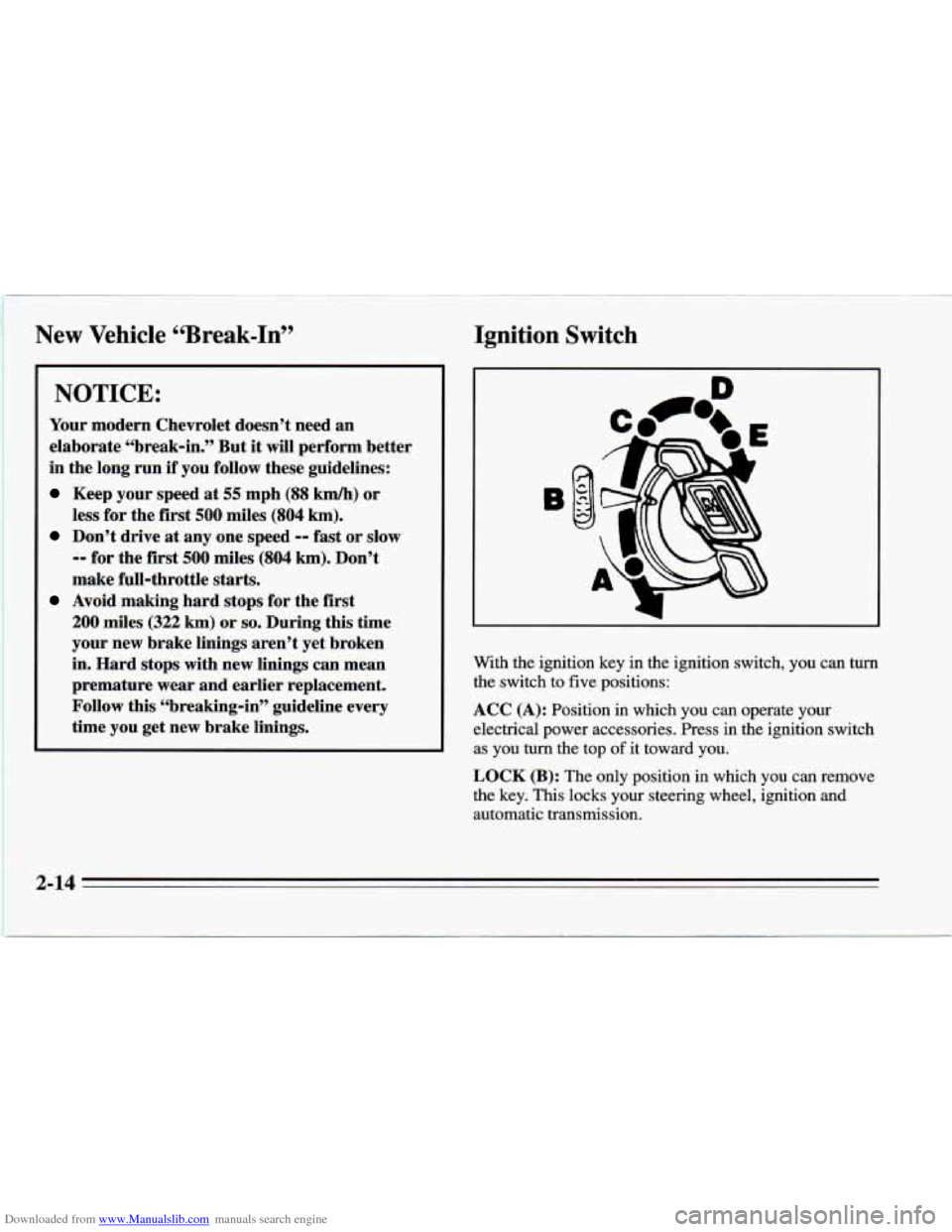
Downloaded from www.Manualslib.com manuals search engine New Vehicle “Break-In” Ignition Switch
NOTICE:
Your modern Chevrolet doesn’t need an
elaborate “break-in.” But it will perform better
in the long run if you follow these guidelines:
Keep your speed at 55 mph (88 km/h) or
less for the first
500 miles (804 km).
Don’t drive at any one speed -- fast or slow
-- for the first 500 miles (804 km). Don’t
make full-throttle starts.
200 miles (322 km) or so. During this time
your new brake linings aren’t yet broken
in. Hard stops with new linings
can mean
premature wear and earlier replacement.
Follow this “breaking-in’’ guideline every
Avoid making hard stops for the first
I
time you get new brake linings. With
the ignition key in the ignition switch, you can turn
the switch to five positions:
ACC
(A): Position in which you can operate your
electrical power accessories. Press in the ignition switch
as you
turn the top of it toward you.
LOCK (B): The only position in which you can remove
the key. This locks your steering wheel, ignition and
automatic transmission.
2-14
Page 67 of 388
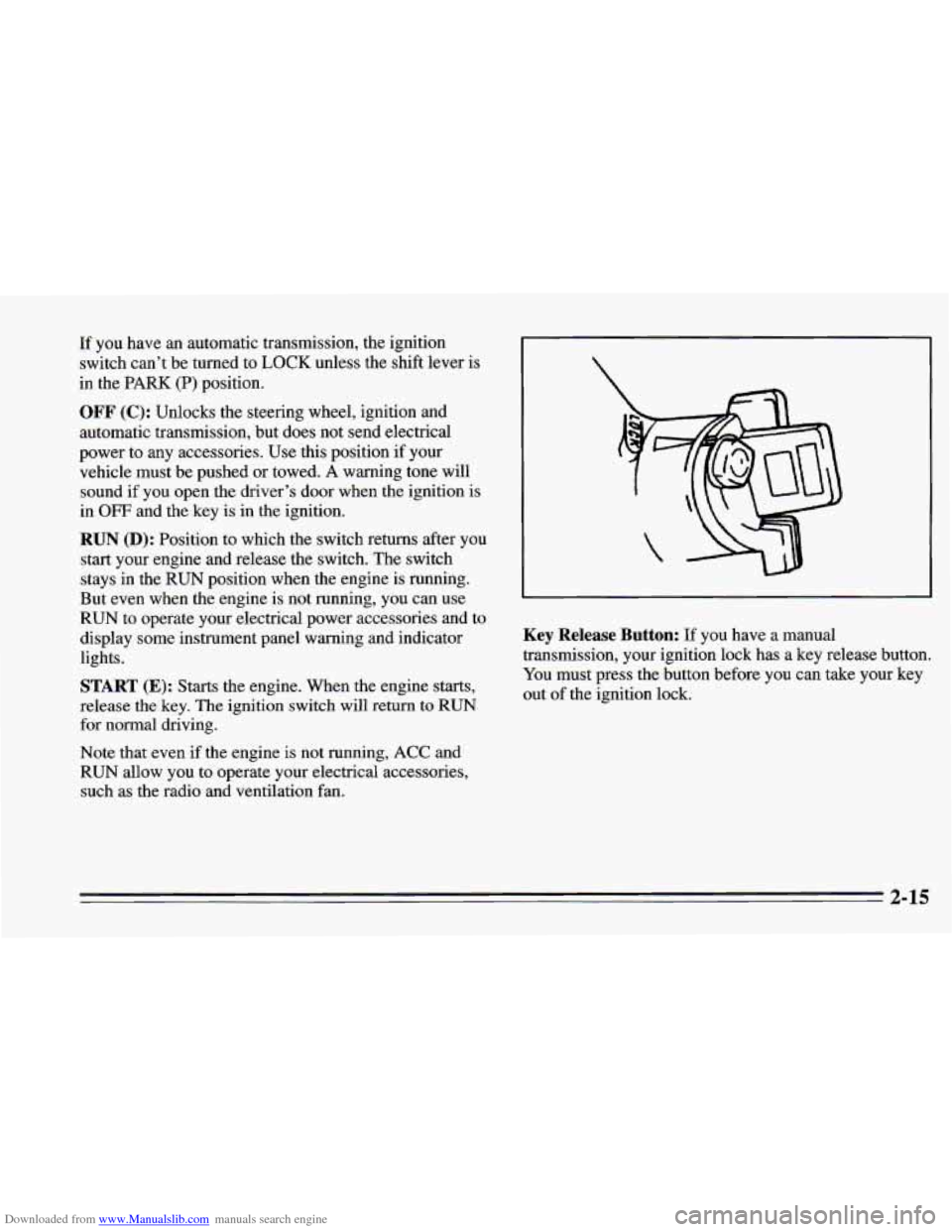
Downloaded from www.Manualslib.com manuals search engine If you have an automatic transmission, the ignition
switch can’t be turned to
LOCK unless the shift lever is
in the PARK (P) position.
OFF (C): Unlocks the steering wheel, ignition and
automatic transmission, but does not send electrical
power to any accessories. Use this position if your
vehicle must be pushed or towed. A warning tone will
sound if you open the driver’s door when the ignition is
in
OFF and the key is in the ignition.
RUN (D): Position to which the switch returns after you
start your engine and release the switch. The switch
stays in the
RUN position when the engine is running.
But even when the engine is not running, you can use
RUN to operate your electrical power accessories and to
display some instrument panel warning and indicator
lights.
START (E): Starts the engine. When the engine starts,
release the key. The ignition switch
will return to RUN
for normal driving.
Note that even if the engine is not running, ACC and
RUN allow you to operate your electrical accessories,
such as the radio and ventilation fan.
Key Release Button: If you have a manual
transmission, your ignition lock has a key release button.
You must press the button before you can take your key
out
of the ignition lock.
2-15
Page 68 of 388
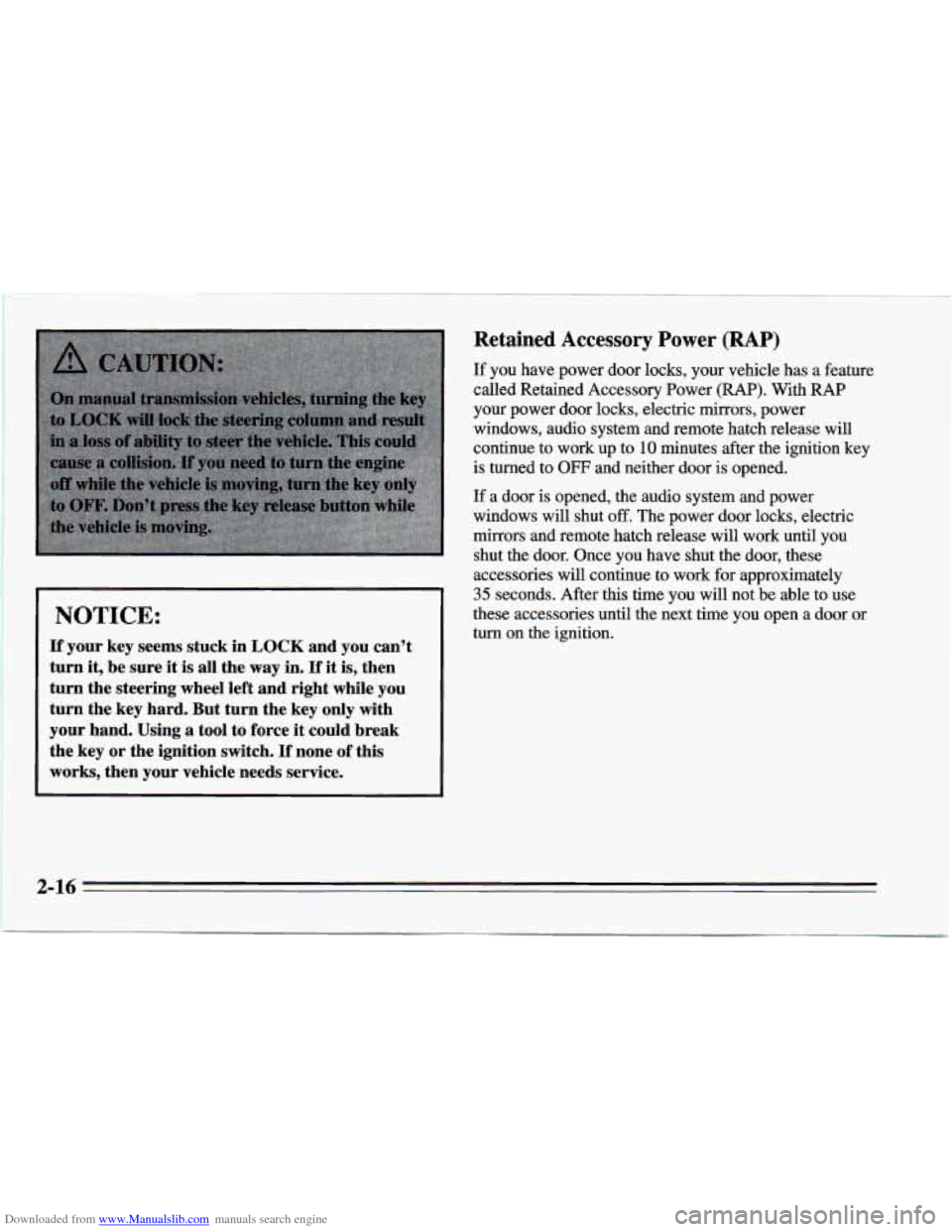
Downloaded from www.Manualslib.com manuals search engine Retained Accessory Power (RAP)
NOTICE:
If your key seems stuck in LOCK and you can’t
turn
it, be sure it is all the way in. If it is, then
turn the steering wheel left and right while you
turn the key hard. But turn the key
only with
your hand. Using a tool to force
it could break
the key or the ignition switch.
If none of this
works, then your vehicle needs service. If you have
power door locks, your vehicle has a feature
called Retained Accessory Power (RAP). With RAP
your power door locks, electric mirrors, power
windows, audio system and remote hatch release will
continue to work up to
10 minutes after the ignition key
is turned to
OFF and neither door is opened.
If a door is opened, the audio system and power
windows will shut
off. The power door locks, electric
mirrors and remote hatch release will work until you
shut the door. Once you have shut the door, these
accessories will continue to work for approximately
35 seconds. After this time you will not be able to use
these accessories until the next time you open a door or
turn on the ignition.
2-16
Page 69 of 388

Downloaded from www.Manualslib.com manuals search engine Starting Your Engine
Automatic transmission:
Move your shift lever to PARK (P) or NEUTRAL (N).
Your engine won’t start in any other position -- that’s a
safety feature.
To restart when you’re already moving,
use NEUTRAL
(N) only.
NOTICE:
Don’t try to shift to PARK (P) if your Chevrolet
is moving. If you do, you could damage the
transmission. Shift to PARK (P) only when your
vehicle is stopped.
Manual transmission:
The gear selector should be in NEUTRAL (N). Hold the
clutch pedal to
the floor and start the engine. Your
vehicle won’t start if the clutch pedal is not all the way
down
-- that’s a safety feature.
To start your V6 engine:
1. Without pushing the accelerator pedal, turn your
ignition key to START. When the engine starts, let
go
of the key. The idle speed will go down as your
engine gets warm.
NOTICE:
Holding your key in START for longer than
15 seconds at a time will cause your battery to be
drained much sooner. And the excessive heat can
damage your starter motor.
2. If it doesn’t start right away, hold your key in
START for about three to five seconds at
a time until
your engine starts. Wait about
15 seconds between
each try to help avoid draining your battery.
3. If your engine won’t start (or starts but then stops), it
could be flooded with too much gasoline.
Try pushing
your accelerator pedal all the way
to the floor and
holding
it there as you hold the key in START for
about three seconds.
If the car starts briefly but then
stops again, do the same thing, but this time keep the
pedal
down for five or six seconds. This clears the
extra gasoline
from the engine. After waiting about 15
seconds, repeat the normal starting procedure.
Page 70 of 388
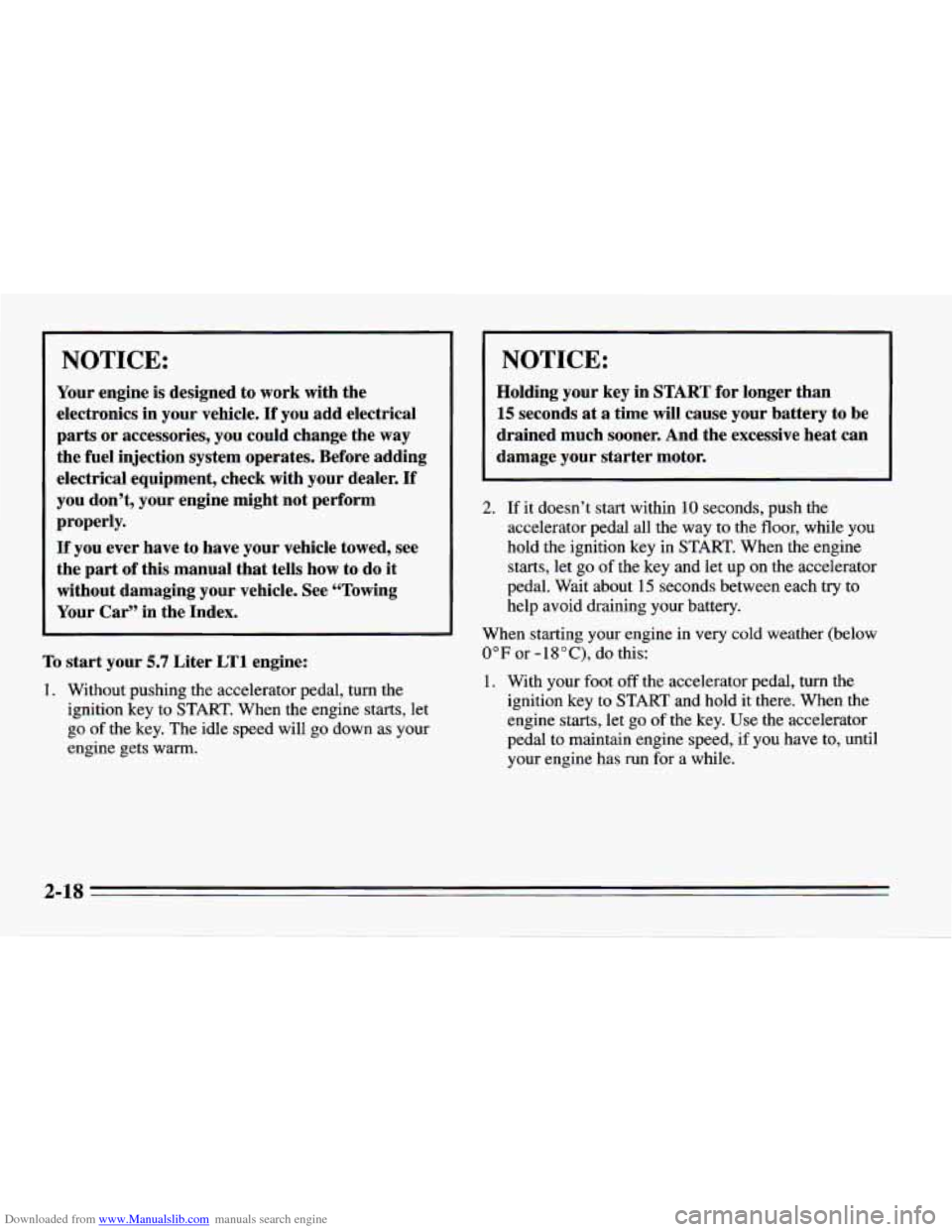
Downloaded from www.Manualslib.com manuals search engine NOTICE:
Your engine is designed to work with the
electronics in your vehicle.
If you add electrical
parts or accessories, you could change the way
the fuel injection system operates. Before adding
electrical equipment, check with your dealer.
If
you don’t, your engine might not perform
properly.
If you ever have to have your vehicle towed, see
the part of this manual that tells how to do
it
without damaging your vehicle. See “Towing
Your Car” in the Index.
To start your 5.7 Liter LT1 engine:
1. Without pushing the accelerator pedal, turn the
ignition key to START. When the engine starts, let
go
of the key. The idle speed will go down as your
engine gets warm.
NOTICE:
Holding your key in START for longer than
15 seconds at a time will cause your battery to be
drained much sooner. And the excessive heat can
damage your starter motor.
2. If it doesn’t start within 10 seconds, push the
accelerator pedal all the way to the
floor, while you
hold the ignition key in
START. When the engine
starts, let
go of the key and let up on the accelerator
pedal. Wait about 15 seconds between each
try to
help avoid draining your battery.
When starting your engine in very
cold weather (below
0°F or -18”C), do this:
1. With your foot
off the accelerator pedal, turn the
ignition key to
START and hold it there. When the
engine starts, let
go of the key. Use the accelerator
pedal
to maintain engine speed, if you have to, until
your engine has run for a while.
2-1s
Page 74 of 388
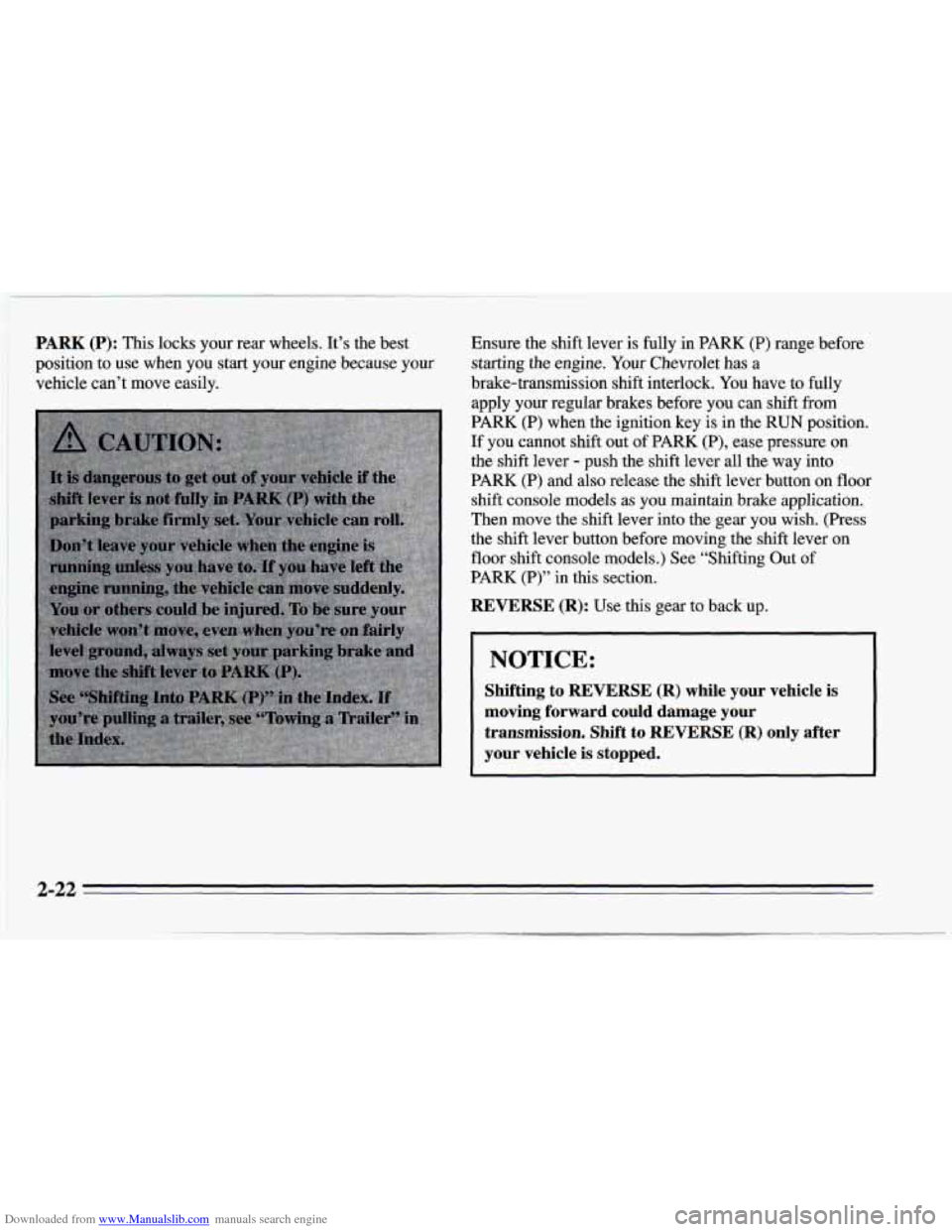
Downloaded from www.Manualslib.com manuals search engine PARK (P): This locks your rear wheels. It’s the best
position to use when you start your engine because your
vehicle can’t move easily. Ensure the
shift lever is fully in PARK (P) range before
starting the engine.
Your Chevrolet has a
brake-transmission shift interlock. You have to fully
apply your regular brakes before you can shift
from
PARK (P) when the ignition key is in the RUN position.
If you cannot shift out of PARK (P), ease pressure on
the shift lever
- push the shift lever all the way into
PARK
(P) and also release the shift lever button on floor
shift console models as you maintain brake application.
Then move the shift lever into the gear you wish.
(Press
the shift lever button before moving the shift lever on
floor shift console models.) See “Shifting Out
of
PARK (P)” in this section.
REVERSE (R): Use this gear to back up.
NOTICE:
Shifting to REVERSE (R) while your vehicle is
moving forward could damage your transmission. Shift to REVERSE
(R) only after
your vehicle is
stopped.
2-22
Page 79 of 388
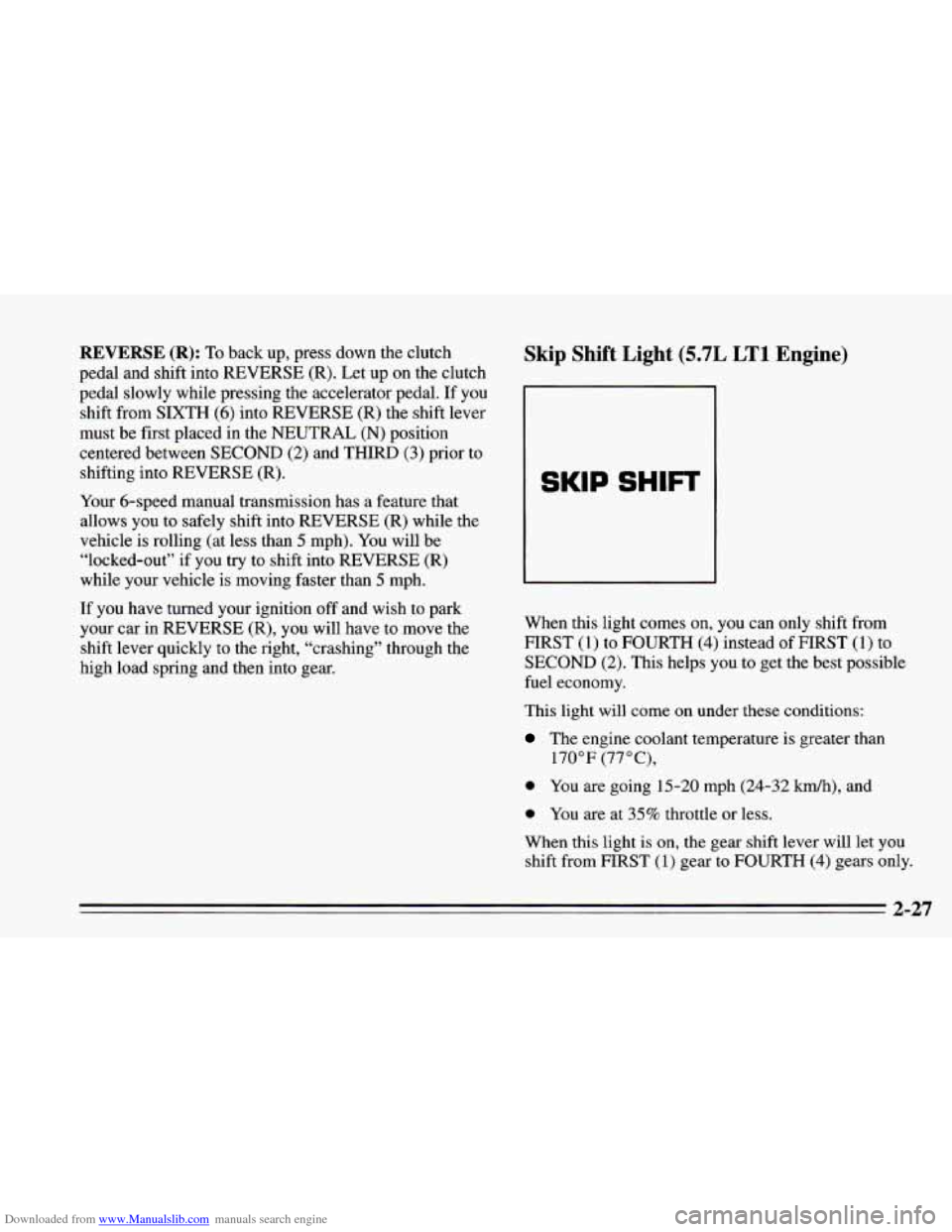
Downloaded from www.Manualslib.com manuals search engine REVERSE (R): To back up, press down the clutch
pedal and shift into REVERSE
(R). Let up on the clutch
pedal slowly while pressing the accelerator pedal. If you
shift from SIXTH
(6) into REVERSE (R) the shift lever
must be first placed in the NEUTRAL
(N) position
centered between SECOND
(2) and THIRD (3) prior to
shifting into REVERSE (R).
Your 6-speed manual transmission has a feature that
allows you to safely shift into
REVERSE (R) while the
vehicle
is rolling (at less than 5 mph). You will be
“locked-out” if you try to shift into REVERSE
(R)
while your vehicle is moving faster than 5 mph.
If you have turned your ignition off and wish to park
your car in REVERSE
(R), you will have to move the
shift lever quickly to the right, “crashing” through the
high load spring and then into gear.
Skip Shift Light (5.7L LTl Engine)
When this light comes on, you can only shift from
FIRST
(1) to FOURTH (4) instead of F’IRST (1) to
SECOND (2). This helps you to get the best possible
fuel economy.
This light will
come on under these conditions:
The engine coolant temperature is greater than
0 You are going 15-20 mph (24-32 kmh), and
0 You are at 35% throttle or less.
170°F (77”C),
When this light
is on, the gear shift lever will let you
shift from FIRST
(1) gear to FOURTH (4) gears only.
2-27
Page 81 of 388
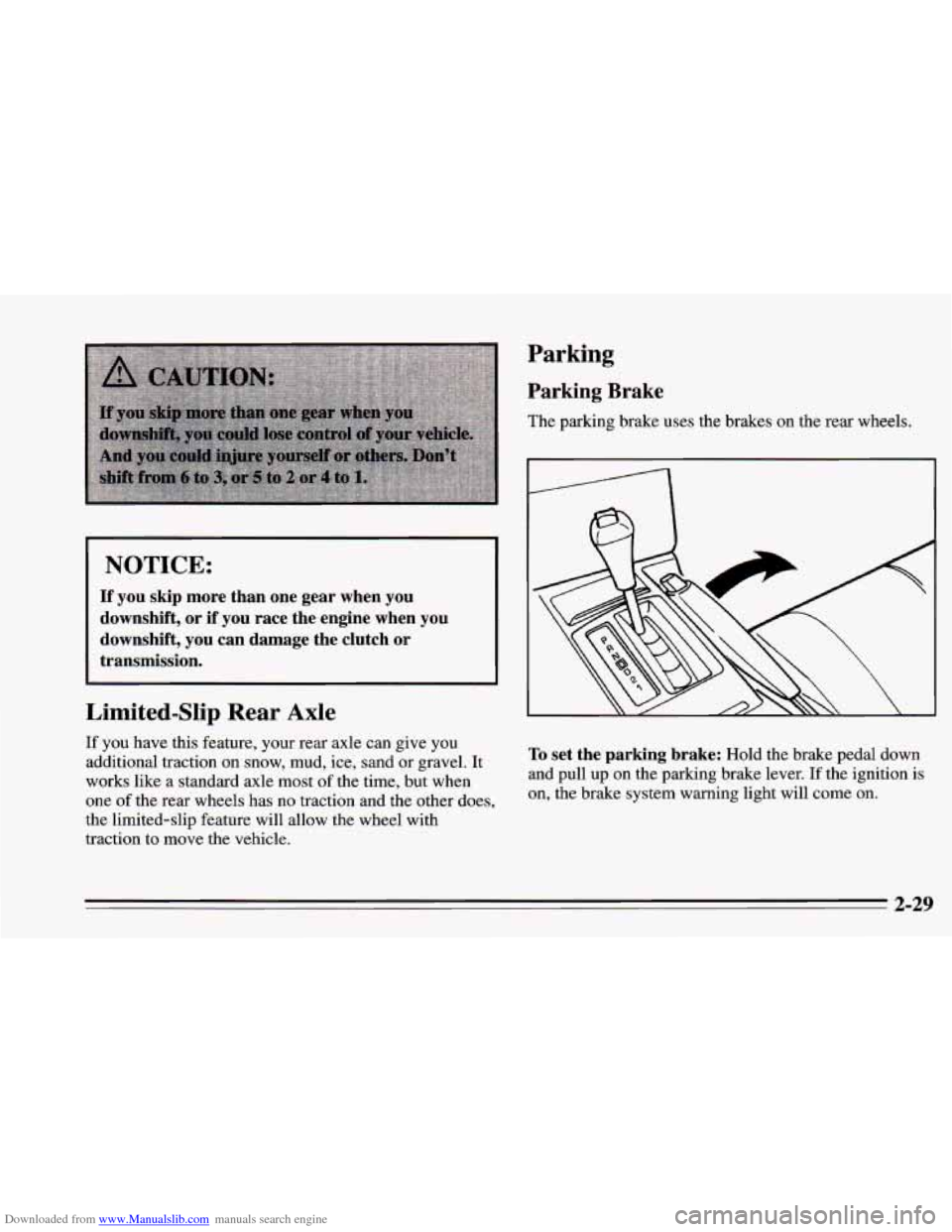
Downloaded from www.Manualslib.com manuals search engine NOTICE:
If you skip more than one gear when you
downshift, or if you race the engine when you
downshift, you can damage the clutch or
transmission.
Limited-Slip Rear Axle
If you have this feature, your rear axle can give you
additional traction on snow, mud, ice, sand or gravel. It
works like a standard axle most
of the time, but when
one of the rear wheels has no traction and the other does,
the limited-slip feature will allow
the wheel with
traction to move the vehicle.
Parking
Parking Brake
The parking brake uses the brakes on the rear wheels.
To set the parking brake: Hold the brake pedal down
and
pull up on the parking brake lever. If the ignition is
on, the brake system warning light will come on.
2-29